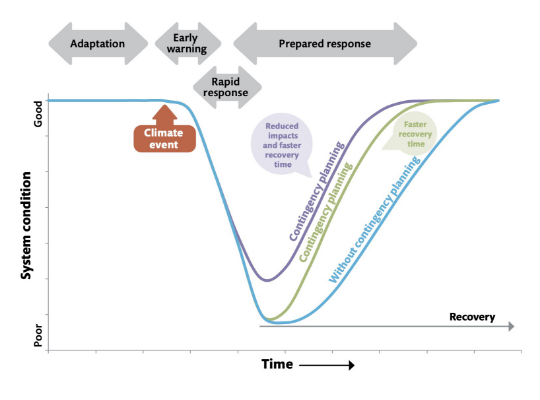Contingency planning
Contingency plans are pre-prepared plans describing when and how a land manager, business or organisation will deal with actual and potential threats to the forest and environment.
Contingency planning for climate change considers both current and future risks related to the changing climate, and both gradual changes and extreme events. These plans aim to reduce risk by enabling a rapid, organised response.
Having appropriate contingency plans in place for spillages, pest and disease outbreaks, extreme weather events and fire is a UKFS Requirement for General Forestry Practice.


Source: UKFS Practice Guide ‘Adapting forest and woodland management to the changing climate’
Download the UKFS Adaptation Practice Guide
Printed copies are available to purchase from Forest Research.
"*" indicates required fields
Benefits of contingency planning
Contingency planning in the forestry sector can minimise impacts to the natural environment and wider social and economic environment and allow forests to continue to meet the desired range of management objectives, allowing a quicker return to normal service.
Benefits of contingency planning include:
- Advance agreement of when and how to respond to threats and risks
- Set thresholds for decision-making
- Key players have been identified and assigned responsibilities
- More likely to produce financial savings
- Increase response rates
- Reduce recovery time
Examples of forestry risks where contingency planning would be useful
- Risk of a pest outbreak increases after a windthrow event, especially if there is a delay in clearing up.
- Risk of wildfire increases during spring and summer after a pest or disease outbreak or following a drought.
- Storing timber and clearing the site after a high wind event may reduce the impact on sales prices, increase timber value and provide opportunities for restocking and diversification.
Guidance notes
- Contingency plans can be developed nationally (UK or country), regionally or locally. The basic content of a small-scale contingency plan will overlap with the forest management plan.
- It is important to check if there are national contingency plans in place and to consider how your local site-based plans might fit within a wider framework (see national contingency plans below).
- Plans should explore potential impact on infrastructure, forest business and important conservation habitats.
- For further advice see the UKFS Practice Guide ‘Adapting forest and woodland management to the changing climate’.
Download the UKFS Adaptation Practice Guide
Printed copies are available to purchase from Forest Research.
"*" indicates required fields

Reducing climate change risks
The following risks may be reduced if the adaptation measure is applied appropriately:
National contingency plans
Our official country guidance pages provide policy information and guidance on climate change.


